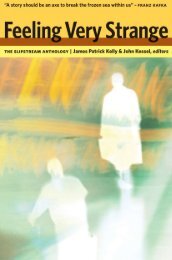The Curse of the Wer.. - Site de Thomas - Free
The Curse of the Wer.. - Site de Thomas - Free
The Curse of the Wer.. - Site de Thomas - Free
Create successful ePaper yourself
Turn your PDF publications into a flip-book with our unique Google optimized e-Paper software.
UPRIGHT CITIZENS ON ALL FOURS<br />
large.’ 1 Certainly, in <strong>the</strong> nineteenth century, <strong>the</strong> creative practices that<br />
generated monsters were closely related to <strong>the</strong> imaginative processes<br />
that located corruption in certain parts <strong>of</strong> <strong>the</strong> community, and <strong>the</strong><br />
<strong>de</strong>scription <strong>of</strong> marginalized groups <strong>of</strong>ten employed <strong>the</strong> language <strong>of</strong><br />
monstrosity.<br />
For example, lycanthropy was <strong>of</strong>ten presented as a threat emanating<br />
from <strong>the</strong> un<strong>de</strong>rclasses. <strong>The</strong> <strong>de</strong>piction <strong>of</strong> <strong>the</strong>se classes in terms <strong>of</strong><br />
an animal physiognomy was not uncommon in nineteenth-century<br />
discourse; Henry Mayhew, for instance, asserted that street people<br />
were notable for a ‘greater <strong>de</strong>velopment <strong>of</strong> <strong>the</strong> animal than <strong>of</strong> <strong>the</strong><br />
intellectual or moral nature <strong>of</strong> man … for <strong>the</strong>ir high cheeks and protruding<br />
jaws’. 2 Representations <strong>of</strong> <strong>the</strong> werewolf drew from a similar<br />
<strong>de</strong>scriptive vocabulary. In his 1865 monograph on <strong>the</strong> werewolf, Sabine<br />
Baring-Gould characterized Gilles Garnier, a peasant accused <strong>of</strong> lycanthropy<br />
in <strong>the</strong> sixteenth century, as ‘a sombre, ill-looking fellow, who<br />
walked in a stooping attitu<strong>de</strong>, and whose pale face, livid complexion,<br />
and <strong>de</strong>ep-set eyes un<strong>de</strong>r a pair <strong>of</strong> coarse and bushy brows, which<br />
met across <strong>the</strong> forehead, were sufficient to repel anyone from seeking<br />
his acquaintance.’ 3 <strong>The</strong> journalist and essayist Andrew Wynter<br />
paraphrased Baring-Gould’s account in an 1875 article on lycanthropy,<br />
adding ‘<strong>the</strong> story affords a good example <strong>of</strong> <strong>the</strong> class <strong>of</strong> people who<br />
were seized with this horrible epi<strong>de</strong>mic’, to ensure that no one missed<br />
<strong>the</strong> point. 4 Representations <strong>of</strong> lycanthropy were not, however, confined<br />
to visualizations <strong>of</strong> lower-class werewolves in <strong>the</strong> nineteenth century.<br />
Depictions <strong>of</strong> aristocratic lycanthropy drew upon middle-class narratives<br />
about <strong>the</strong> <strong>de</strong>cay <strong>of</strong> <strong>the</strong> nobility in contrast to bourgeois vitality,<br />
as a passage from a novella by M.M. Erckmann-Chatrian illustrates.<br />
Narrated by a middle-class interloper, <strong>the</strong> tale relates <strong>the</strong> tragic curse<br />
<strong>of</strong> a noble family.<br />
[T]he sight that met my eyes ma<strong>de</strong> <strong>the</strong> blood run chill as snow in my veins.<br />
<strong>The</strong> lord <strong>of</strong> Ni<strong>de</strong>ck, crouching on all fours upon his bed, with his arms<br />
bending forward, his head carried low, his eyes glaring with fierce fires,<br />
was uttering loud, protracted howlings!<br />
He was <strong>the</strong> wolf!<br />
That low receding forehead, that sharp-pointed face, that foxy-looking<br />
beard, bristling <strong>of</strong>f both cheeks; <strong>the</strong> long meagre figure, <strong>the</strong> sinewy<br />
45





